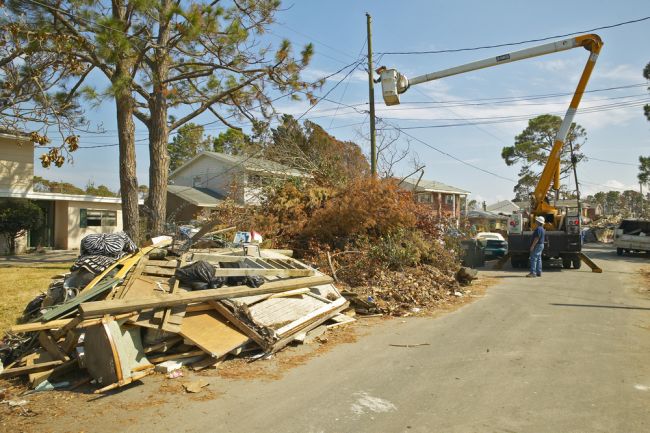
The Storm Work Security Conundrum
How A New Zealand-Based Company is Hoping to Revolutionize the Ways Utility Organizations can Quickly Verify Worker Security Credentials, Skills and Training Qualifications

As storm restoration work becomes more frequent, so do the challenges of verifying that the workers that flock to the disaster areas are qualified to do the work as well as meet background checks and security verifications they need. We talked with Dan Stemp, the chief customer officer at JNCTN, a New Zealand-based company that is hoping to bring a solution to the U.S. market that will not only empower utilities to verify workers but also give the workers ownership of that information. Included in the discussion is Alex Wakeland, a journeyman lineman for the International Brotherhood of Electrical Workers and a JNCTN product champion.
Curtis Marquardt:
Storm restoration work in the U.S. typically requires utility workers to descend upon the impacted area from all over the country. From a security perspective, what are the biggest concerns utilities should have about this way of restoring services?
Alex Wakeland:
As a journeyman lineman, I have seen this firsthand very often. The main problem is that you have a flood of utility workers descending upon the restoration area from all over the country, but there’s no way for the utility company to quickly verify all the paperwork to make sure they have the background, experience, security clearance and training to do the job. They simply don’t have enough staff. Ideally, utilities would have their own in-house staff to handle everything, but that’s not always cost-effective. So, they hire subcontractors. However, this can create challenges when it comes to verifying worker qualifications as well.
Additionally, from a logistical perspective, sometimes utilities have rules where they require each crew to have one journeyman lineman, one apprentice lineman and one groundman. This really slows down the process as they wait on traditional paperwork to verify and group these teams. Often, these storm restoration workers get down on-site and have to wait for days to actually be cleared to start working. It’s an incredibly inefficient process.
Curtis Marquardt:
JNCTN has a solution that can help with this challenge and provide utilities with a tool to help them be more secure and efficient.Can you talk about that solution?
Dan Stemp:
Correct. Our solution is what I like to call digital protective equipment, or DPE—modeled off the common industry term “personal protective equipment.” What we do is provide a digital wallet for individual workers. For example, someone like Alex can create a digital wallet on their device. This wallet allows them to create credentials for themselves, and they can be imported from the organizations that employ them or provide their training.
These credentials are created using open standards so they can be interoperable with other systems. For example, a utility company could use our system to verify that a worker has the necessary qualifications before allowing them access to a worksite. This would improve security and efficiency. This information could be stored electronically so that when a crew arrives at a worksite, it can be quickly verified that they meet the qualifications. This would improve security, billing and safety metrics.
Alex Wakeland:
There are many advantages to this approach, but the first step is getting utilities to agree to a standardized system. This will make the industry more efficient and help us recover from disasters more quickly. Disasters are never a good thing, but we can make them a little bit better.
Dan Stemp:
The key is to ensure that the people responding to the disaster are who they say they are and have the necessary skills and training to do the job safely and do not compromise security.
Alex Wakeland:
Exactly. This is not just about protecting personal data; it’s about improving safety, security and efficiency across the entire industry.
Dan Stemp:
This is a solution that can be applied to any sector, not just energy. In New Zealand, we’ve had success in the forestry and high-hazard industries as well. What’s great about our system is that it allows workers to own and manage their own credentials. They can then choose to share these credentials with authorized organizations or revoke them. They own it.
Alex Wakeland:
In a world where data leaks create a whole host of problems, we found the system provides a centralized ecosystem for all consumers where the consumer controls access to their own data. This also solves another inefficiency, which is duplicate training. Often, when a worker leaves one job for another, getting the training records from the previous employer isn’t always so easy. So often, the new employer requires that employee to do the same training all over again. If each worker can control their own verified personal job data, they can easily produce proof of training themselves.
Curtis Marquardt:
One area I’m thinking about is access control into sensitive areas of a facility. Can this solution integrate with existing access control systems used by utilities to help with the verification process whether they are an employee, contractor or other?
Dan Stemp:
Great question. The answer is yes. Our software is built to be interoperable with many other solutions. For example, a large company might have a human resources system that holds information you want to use. Our platform can connect with that existing system via API to avoid redundant data entry. The same goes for access systems. If someone’s credentials match requirements, the platform can grant access. JNCTN allows credentials to have more utility. So, a person’s credentials might allow specific actions.
Let’s say there’s a geothermal power station with safety rules for entry. When someone arrives at the gate, they wouldn’t have to find every single credential. The person at the gate can select the rule set or location that applies, requiring specific credentials. If the person has them all, it’s just a scan of a QR code from their digital wallet.
The system checks everything and grants access. JNCTN isn’t saying someone has this or that credential, it’s just checking a pre-created rule set. The person at the gate might just be a security guard who sees a message saying “meets requirements” or “doesn’t meet requirements.” There can then be specific rules the guard follows if someone doesn’t meet the set. For example, maybe someone is missing a site induction, but it’s their first time there, so they might be allowed in with an exemption.
Our product can create a digital audit trail of all that. The New Zealand government used JNCTN for their pandemic response, managing isolation and quarantine facilities. Workers turning up for their shift each day had their credentials verified through our platform.
Curtis Marquardt:
So, you brought up New Zealand. This system has been implemented into real-world utility industry applications there and has proven to be effective. Can you talk more about how it was implemented and the successes it brought?
Dan Stemp:
The New Zealand and U.S. markets are quite different, and our approaches differed as well. In New Zealand, there was a very supportive industry environment. As I mentioned earlier, the entire industry came together and acknowledged the need to improve worker safety. They wanted workers to go home safely to their families and feel secure knowing they’re working alongside people who meet the same qualifications.
The New Zealand utility companies, specifically the generation companies, took the lead. They created an initiative with a branded name, “Stay Safe,” to identify it across the industry and drive its adoption. It wasn’t just about our technology; the initiative encompassed other aspects related to worker health, safety and security. Having the generation companies at the forefront ensured buy-in from everyone in the industry, from subcontractors to transmission and distribution companies. New Zealand has a smaller workforce, but our generation capacity is significant at 9,500 megawatts nationwide.
New Zealand has a substantial workforce, and the generation companies prioritized their employees first.They then collaborated with subcontractors who work in those environments, including plumbers, builders, scaffolders, utility workers and generation workers themselves. This broad approach ensures everyone who touches the industry is included.
And the benefits extend beyond the energy sector, as subcontractors see the value in other industries. For example, a scaffolder who obtains credentials for a generation site’s maintenance can use those same credentials in the construction industry, demonstrating their scaffolding ticket and working-at-height certificate. This experience is fostering a broader mindset across industries: There’s a way to do this, and it’s working, so maybe we should adopt it. But really, it’s our success in the utility segment in New Zealand that really has us looking at ways we can help in U.S.-based utilities. We hope to see a similar adoption and collaborative approach in the U.S. where workers can leverage credentials across industries.
Alex Wakeland:
This is the utopia we’re striving for, but there are steps to get there. Every other tech company seems to think this is a one-size-fits-all solution.
Dan Stemp:
The flow-on effect is important, but establishing the use case and demonstrating value is crucial first.
Alex Wakeland:
We recognize there might be imperfect measures to get us there, but they bridge the gap to the next step. JNCTN is working on it. They talk to the frontline workers who will manage this. Most conversations I get are like, “How do you even show up for storms?” It’s as if they’re trying to manage us without understanding. Just come talk to us! We’ll tell you about the challenges.
To learn more about JNCTN, visit JNCTN.nz.